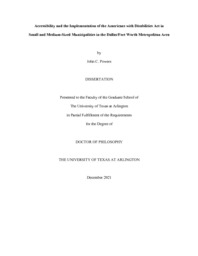
ATTENTION: The works hosted here are being migrated to a new repository that will consolidate resources, improve discoverability, and better show UTA's research impact on the global community. We will update authors as the migration progresses. Please see MavMatrix for more information.
Show simple item record
| dc.creator | Powers, John C. | |
| dc.date.accessioned | 2022-01-25T18:21:45Z | |
| dc.date.available | 2022-01-25T18:21:45Z | |
| dc.date.created | 2021-12 | |
| dc.date.issued | 2021-11-29 | |
| dc.date.submitted | December 2021 | |
| dc.identifier.uri | http://hdl.handle.net/10106/30199 | |
| dc.description.abstract | People with disabilities face daily physical challenges posed by inaccessible buildings and unsafe sidewalks or public parks. These barriers prevent millions of people from enjoying resources provided by municipalities across the countries, such as public parks, libraries, and community centers. The Americans with Disabilities Act (ADA) of 1990, later amended in 2008, was designed to guide municipalities in the removal of those barriers to offer a more inclusive living environment for people with disabilities.
Title II of the ADA requires municipalities to ensure that their sidewalks, public parks, and public buildings are accessible. Additionally, public programs such as city council meetings must also be accessible to those with disabilities. The ADA has provided guidelines for municipalities to follow to become compliant with the law. Compliance with the law should, in theory, provide a more accessible built environment for all.
Previous research studies have shown that many municipalities across the country have been slow in implementing Title II of the ADA. The purpose of this research study will be to gain a greater understanding of the level of compliance with Title II for small and medium size municipalities of the Dallas/Fort Worth metropolitan area. Additionally, this study will address the factors affecting the level of compliance by these municipalities. The results of this research may provide a blueprint for municipalities still struggling with the full implementation of Title II.
Using the mixed research method, this research provided an updated insight into the challenges faced by small and medium-size municipalities in the Dallas/Fort Worth metropolitan area when striving for compliance. The data suggests that 75% of these municipalities with 50 or more employees (a key benchmark for ADA compliance) fall short of compliance in a number of ways. First, most municipalities in the area have not created a Transition Plan or conducted a self-evaluation to determine their level of compliance. Second, many have not designated an employee of the municipality as the ADA Coordinator, another requirement of Title II. These two critical factors have a cascading impact on the level of compliance of the municipalities with 50 or more employees.
Many municipalities with less than 50 employees in this study area also fell short of full compliance with the law. As expected, the data illustrate the budgetary and staffing challenges faced by municipalities of all sizes in the study when striving for compliance. Additionally, these smaller municipalities indicated a lack of understanding of the requirements of the law, further complicating compliance. The results of this study show that even after more than three decades of existence, many municipalities in the Dallas/Fort Worth Metropolitan area have yet to achieve compliance with Title II of the ADA. | |
| dc.format.mimetype | application/pdf | |
| dc.language.iso | en_US | |
| dc.subject | Accessibility | |
| dc.title | Accessibility and the Implementation of the Americans with Disabilities Act in Small and Medium-Sized Municipalities in the Dallas/Fort Worth Metropolitan Area | |
| dc.type | Thesis | |
| dc.contributor.committeeMember | Anjomani, Ardeshir | |
| dc.contributor.committeeMember | Audirac, Ivonne | |
| dc.contributor.committeeMember | Shen, Guoqiang | |
| dc.degree.department | Urban and Public Affairs | |
| dc.degree.name | Doctor of Philosophy in Urban Planning and Public Policy | |
| dc.date.updated | 2022-01-25T18:21:45Z | |
| thesis.degree.department | Urban and Public Affairs | |
| thesis.degree.grantor | The University of Texas at Arlington | |
| thesis.degree.level | Doctoral | |
| thesis.degree.name | Doctor of Philosophy in Urban Planning and Public Policy | |
| dc.type.material | text | |
Files in this item
- Name:
- POWERS-DISSERTATION-2021.pdf
- Size:
- 19.80Mb
- Format:
- PDF
This item appears in the following Collection(s)
Show simple item record


